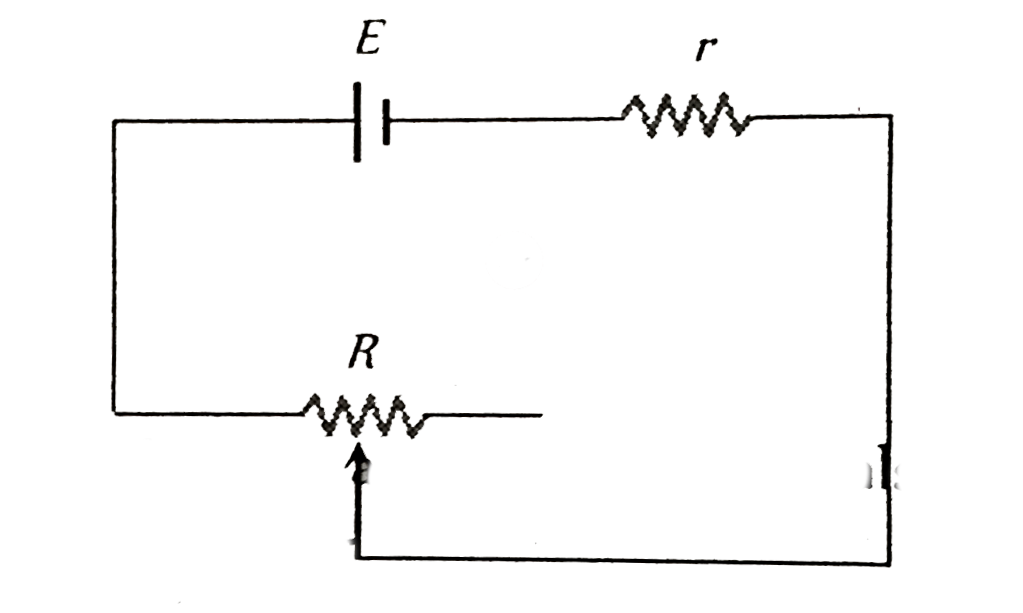An external resistance R is connected to a battery of e.m.f. V and internal resistance r . The joule heat produced in resistor R is maximum when R is equal to
r
r2
2r
Infinitely large
The correct Answer is:A
To solve the problem of finding the value of external resistance R that maximizes the Joule heat produced in it when connected to a battery with an electromotive force (e.m.f.) V and an internal resistance r, we can follow these steps:
1. Understand the Circuit:
We have a battery with e.m.f. V and internal resistance r connected to an external resistor R.
2. Determine the Current:
The total resistance in the circuit is the sum of the internal resistance and the external resistance, which is R+r. The current I flowing through the circuit can be expressed using Ohm's law:
I=VR+r
3. Calculate the Power (Joule Heat):
The power P dissipated in the external resistor R (which is the Joule heat produced) is given by:
P=I2R
Substituting the expression for I:
P=(VR+r)2R=V2R(R+r)2
4. Maximize the Power:
To find the value of R that maximizes P, we can take the derivative of P with respect to R and set it to zero:
dPdR=0
5. Differentiate the Power Expression:
Using the quotient rule for differentiation:
dPdR=(R+r)2⋅V2−V2R⋅2(R+r)(R+r)4
Simplifying the numerator:
V2((R+r)2−2R(R+r))=V2(R2+2Rr+r2−2R2−2Rr)=V2(r2−R2)
6. Set the Derivative to Zero:
Setting the numerator equal to zero for maximization:
r2−R2=0
This implies:
r2=R2⟹R=r
7. Conclusion:
The Joule heat produced in the resistor R is maximum when the external resistance R is equal to the internal resistance r.
Final Answer:
The Joule heat produced in resistor R is maximum when R=r.
We have a battery with e.m.f. V and internal resistance r connected to an external resistor R.
The total resistance in the circuit is the sum of the internal resistance and the external resistance, which is R+r. The current I flowing through the circuit can be expressed using Ohm's law:
I=VR+r
The power P dissipated in the external resistor R (which is the Joule heat produced) is given by:
P=I2R
Substituting the expression for I:
P=(VR+r)2R=V2R(R+r)2
To find the value of R that maximizes P, we can take the derivative of P with respect to R and set it to zero:
dPdR=0
Using the quotient rule for differentiation:
dPdR=(R+r)2⋅V2−V2R⋅2(R+r)(R+r)4
Simplifying the numerator:
V2((R+r)2−2R(R+r))=V2(R2+2Rr+r2−2R2−2Rr)=V2(r2−R2)
Setting the numerator equal to zero for maximization:
r2−R2=0
This implies:
r2=R2⟹R=r
The Joule heat produced in the resistor R is maximum when the external resistance R is equal to the internal resistance r.
The Joule heat produced in resistor R is maximum when R=r.
Topper's Solved these Questions
- BOOK - ERRORLESS CHAPTER - HEATING AND CHEMICAL EFFECT OF CURRENTEXERCISE - Heating Effect of Current2videos
HEATING AND CHEMICAL EFFECT OF CURRENT
- BOOK - ERRORLESS CHAPTER - HEATING AND CHEMICAL EFFECT OF CURRENTEXERCISE - Chemical Effect Current1videos
HEATING AND CHEMICAL EFFECT OF CURRENT
- BOOK - ERRORLESS CHAPTER - ELECTROSTATICS EXERCISE - Ordinary Thinking Objective Questions (Electric Flux and Gauss.s Law)28videos
ELECTROSTATICS
- BOOK - ERRORLESS CHAPTER - KINETIC THEORY OF GASESEXERCISE - QUESTIONS126videos
KINETIC THEORY OF GASES
Similar Questions
If a battery of emf E and internal resistance r is connected across a load of resistance R. Shot that the rate at which energy is dissipated in R is maximum when R=r and this maximur power is P=E2/4r.
View SolutionAn total resistance R is connected to a cell of internal resistance r the maximum current flows in the external resistance, when
View Solution
Knowledge Check
- Question 1 - Select One
An external resistance R is connected to a cell of internal resistance r. The current in the circuit is maximum when
AR<rBR>rCR=rDR=2r - Question 2 - Select One
Statement I: When an external resistor of resistance R (connected across a cell to internal resistance r ) is varied, power consumed by resistance R is maximum when R = r.
Statement II: Power consumed by a resistor of constant resistance R is maximum when current through it is maximum.AStatement I is true, Statement II is True, Statement II is a correct explanation for Statement I.BStatement I is True, Statement II is True, Statement II is not a correct explanation for Statement I.CStatement I is True, Statement II is False.DStatement I is False, Statement II is True. - Question 3 - Select One
Two cells , each of emfE and internal resistance r, are connected in parallel across a resistor R. The power delivered to the resistor is maximum if R is equal to
Ar/2BrC2rD0
The maximum power dissipated in an external resistance R, when connected to a cell of emf E and internal resistance r, will be
View SolutionA battery of e.m.f. E and internal resistance r is connected to a variable resistor R as shown here. Which one of the following is true
 View Solution
View SolutionA battery of emf E and internal resistance r is connected to a resistor of restance r1 and Q Joules of heat is produced in a certain time t. When te same battery is connected to another resistor of resistance r2 the same quantity of heat is produced in the same time t. Then the value of r is
View SolutionA cell of internal resistance r connected across an external resistance R can supply maximum current when
View SolutionA battery of e.m.f. 10V and internal resistance 0.5ohm is connected across a variable resistance R. The value of R for which the power delivered in it is maximum is given by
View Solution

